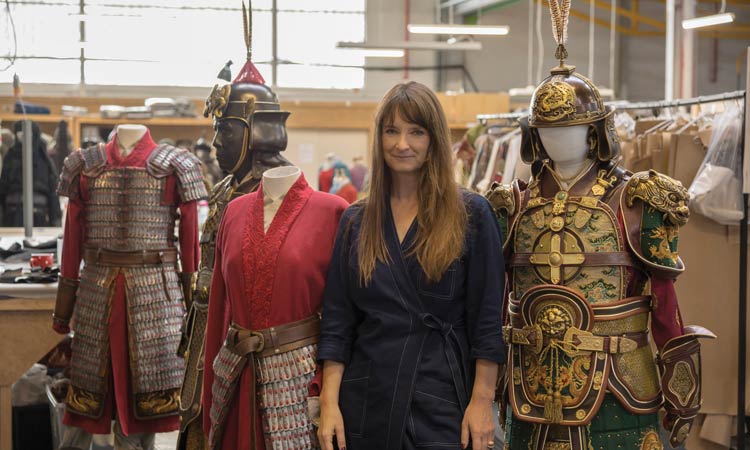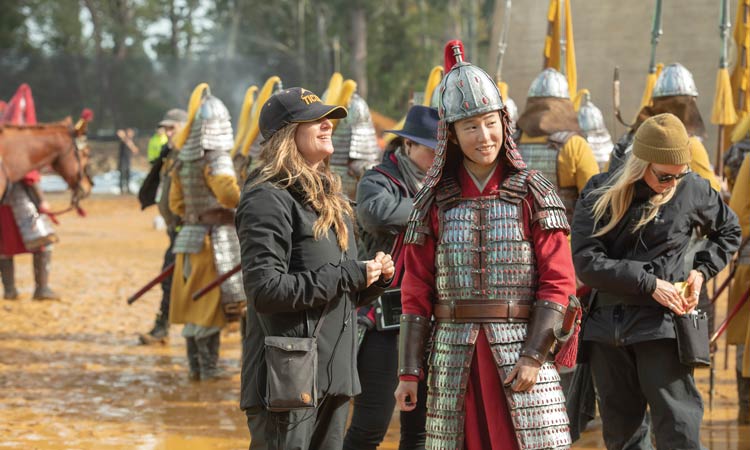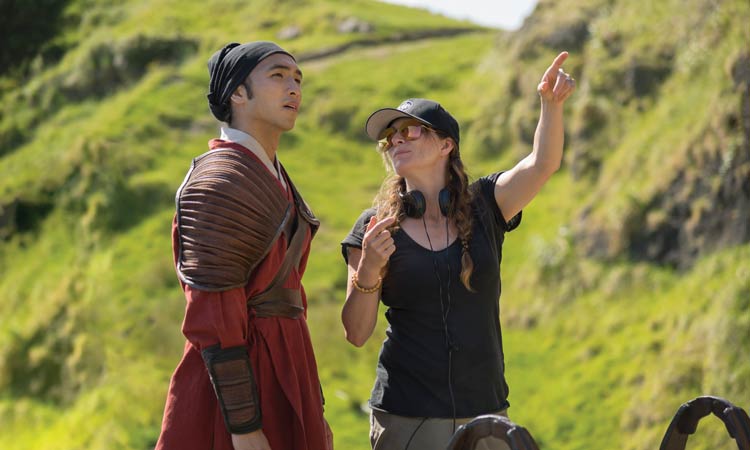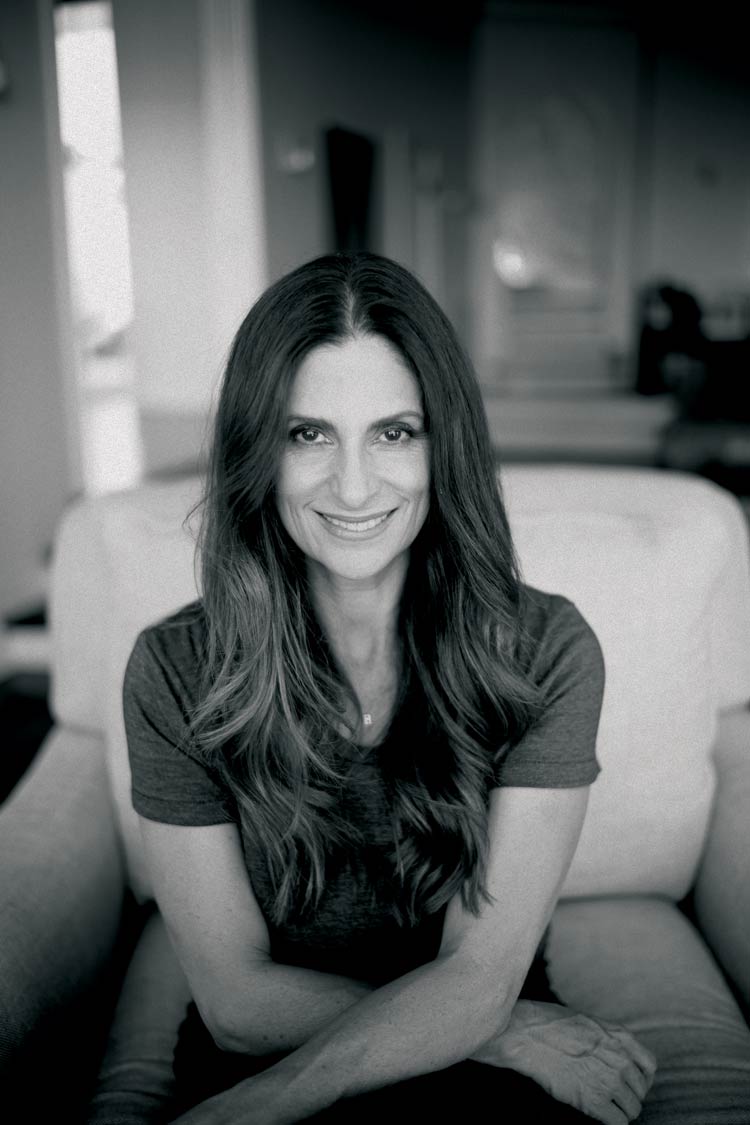It’s early January 2020 and SciFiNow is among what’s apparently the first audience to see select full scenes from one of the year’s most intriguing blockbuster prospects. We’re very impressed by the thrilling scale and tender, moving intimacy of the wildly different sequences we’re shown. And this is somewhat surprising because this film is one of those oft-dreaded propositions: a remake.
Well, yes and no to it being a strict remake of another movie. Disney’s new Mulan is definitely a live-action update of its own animated film from 1998, but the character of Hua Mulan originates in a famous story first told over 1,500 years ago, in which a young woman, disguised as a man, took her aging father’s place in the army. In paying tribute to various versions of the story, as well as the character’s importance for Chinese audiences, the new Mulan is a very different beast from its Disney predecessor.
Development on this adaptation began in 2015, with Niki Caro being hired to direct in February 2017. Caro had not previously directed an action film, but the New Zealand filmmaker had a critical and commercial success for Disney on her resume already: the Kevin Costner sports drama McFarland, USA (2015). Additionally, two of her prior features prominently showcased her skill with stories of women standing up to or navigating their way through traditionally male-dominated spaces. Her first American film, North Country (2005), told an account of the first major successful sexual harassment case in the United States, and her breakthrough debut feature, Whale Rider (2002), made in New Zealand, told the story of a young Māori girl fighting to fulfil her destiny in the context of a patriarchal tribe.

Disney is said to have sought an Asian director for Mulan at first, with Ang Lee among those reportedly meeting with the studio but passing. Though Caro’s hiring is a boost in a studio system where women-helmed mega-budget blockbusters are still rare, the optics of a white filmmaker directing a Chinese story are not lost on her. “McFarland, USA also had a very specific set of cultural requirements because it was set in the Mexican-American fieldworker community,” Caro tells SciFiNow. “So, I think Disney felt very comfortable that I could handle the cultural imperatives of making a movie like this.”
William Kong, the Hong Kong-based producer of Crouching Tiger, Hidden Dragon and other international crossover smashes, was hired by Disney as an Executive Producer on the film. “Bill was the first person I spoke to,” Caro continues. “I’m not Chinese, and I’m not Māori either in regards to when I did Whale Rider. But I have made a lot of movies outside of my culture and I have a way of doing it where I take the responsibility of the cultural authenticity very, very seriously. And so, the first thing I wanted to do when I got this job was to speak to Bill and start to have those conversations about how I might deliver a film that everybody loves, but, in particular, that Chinese – and Asian people too, generally – can feel very proud of in the way they clearly, and should, feel proud of Mulan.”
Caro was on board all through a year-long worldwide search of nearly 1,000 candidates for the lead role, with the criteria being that the actor of Chinese descent had to have a certain star quality, the ability to speak fluent English, credible martial arts skills for a physically intense shoot, and a look that could plausibly veer into androgyny, so that Mulan’s hiding within the army ranks would be remotely believable. So, not a lot of asks then. Additionally, the person they eventually cast is also a trained singer, though Caro tells us that her Mulan is categorically not a musical, but that “music is used in interesting ways”.
In November 2017, Chinese-American actor Liu Yifei was cast as Mulan. The rest of the main cast is largely made up of Chinese industry superstars – Donnie Yen, Jet Li, Gong Li – and familiar Chinese-American faces – Jason Scott Lee as villain Bori Khan, Tzi Ma as Mulan’s father. Principal photography finally began in summer 2018, across China and New Zealand.

“One of the really nice things about Disney,” Caro says, “in my personal experience, is that they’re very director-friendly and focused. They shared the vision for this film and just gave me the tools to execute that. When I sign up for something, I’m all in. The entirety of my body, mind, soul is in a movie and there is no way I would be separated from the vision of one. And certainly, there was never any moment in the entire three years that I didn’t feel that Disney was hugely supportive of that vision.”
The earliest known transcription of ‘The Ballad Of Mulan’ was in the 6th Century, with the earliest extant text of the poem being located in an anthology dating back to either the 11th or 12th Century. In written form and spoken tale, the ballad’s story has been told in so many different ways. Hua Mulan has also appeared in novels, stage plays, television series and, as we know, films. When it comes to cinema, at least five film versions made in Asia preceded Disney’s first stab at the material. Concerning story influences from the earlier incarnations, Caro says: “I didn’t go back to all of them. I was, of course, very aware of how many times Mulan has been made and in all different various forms in China, even all the way to opera. But it had never been made on this scale, or in this language, under the Disney banner. And so that presented a really amazing opportunity.”
Being both faithful to and different from the animated film means a few character changes. Caro suggests her heroine is shown as an accomplished horse rider before she heads to war. And while far from a trained fighter, she’ll have some degree of combat prowess under her belt already, in unique ways. “What she is very good at as a child is that she’s very calm, physically,” Caro tells us. “We see her as a young girl practicing martial arts in secret. Her chi is immensely powerful and innate in her even as a little girl. And so, there’s a very sweet mini action sequence at the beginning of the movie where we see, in a very unlikely way, just how physically strong and agile she is.”
Other character changes from the animated version include the outright absence of many hallmarks of the Disney musical. The villains are different, few character names carry over, and there’s reportedly no Eddie Murphy-voiced dragon named Mushu helping Mulan on her journey. But while the talking animal sidekicks are gone and the story’s more grounded, Caro suggests the fantastical hasn’t been removed entirely. For one thing, Gong Li’s antagonist is a witch with shapeshifting abilities. And while Mushu may be absent, preview footage teases that another creature may be filling in as a guardian spirit of sorts.
“The thing for me about telling the Mulan story in live-action is that it gets to be real,” Caro says. “Actually real. And that’s thrilling. So, with that commitment to realism on an epic scale, we were in real landscapes. It was about balancing some of the more magic elements and the grounded realism that makes this movie somewhat unusual but special, I think, to keep all of those things in balance.”

For the large-scale sets, Caro was reunited with Grant Major, a frequent Peter Jackson collaborator who was the production designer on Whale Rider and won an Oscar for his work on The Lord Of The Rings: The Return Of The King. “I love Grant,” Caro enthuses. “I love his eye, his style and his taste. But I think the thing that I love about Grant above everything else is that the scale of his vision is equal to mine. So, with Grant and I, our two heads together, this was always going to be… epic’s a very easy word to use, but it genuinely is!
“It’s unusual in a movie of this genre and scale to have so much that’s in-camera, that’s so much shot on location. We have a throne room scene that in another movie may have been just the throne and greenscreen, but in our movie is a huge throne room. Even I was shocked when I went into it for the first time. When we were working on the design, I kept saying: ‘Oh Grant, is it big enough?’ And he said: ‘Niki, it goes to the outside walls of the biggest stage we have!’ And when I walked into it the first time, I was like: ‘Holy shit!’ It’s huge and it’s all real. And it’s wonderful too. It’s wonderful for actors to work in sets that are real.”
The scale of Mulan astounds. Caro mentions that David Lean’s epic Lawrence Of Arabia (1962) was a conscious influence on the film and indicates that a good chunk of the movie was shot on 65mm film, with similar lenses to those used on Lawrence back in the day. Talking about Australian cinematographer Mandy Walker, Caro says: “My collaboration with Mandy has been one of the best of my career. She’s an artist, a visionary and she pulled off a very rare and special trick with this movie in that we deliver scale and visceral raw action in the cinematography, but also absolute beauty all the time. And that feminine approach, like being really strong and kick-arse where we need to be but being beautiful and sensitive also, is something you get with the great cinematographers, of which Mandy is certainly one. Her feminine vision is really a very strong part of this movie.”
Concluding our chat, Caro discusses how, despite the gargantuan upgrade in terms of budget and resources, she sees Mulan as of a piece with debut feature Whale Rider: “Both of them [have] strong and unusual female protagonists in cinema terms, but in human terms they are ordinary girls with unusual strength. And in both of those movies, what’s starting to be recognised in them as little girls is seen as not appropriate. And yet, they are born to be leaders and they are born to be warriors and heroes. In that way, they are emblematic of any number of young girls. And I hope young girls rise up in their millions now, inspired by a movie like this to step into their own power and potential.”
Mulan will be available on Disney+ on 4 September priced at £19.99.
